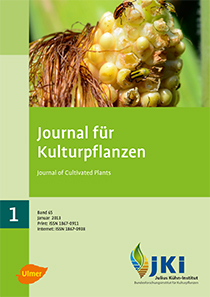Efficacy of entomopathogenic nematodes against the frit fly <em>Oscinella frit</em> (L.) (Diptera: Chloropidae) on spring wheat
DOI:
https://doi.org/10.5073/JfK.2013.01.02Keywords:
Oscinella frit, spring wheat, biological control, λ-cyhalothrin, yieldAbstract
The efficiency of three species of entomopathogenic nematodes (EPNs) (Steinernema carpocapsae, S. feltiae and Heterorhabditis bacteriophora) and one pyrethroid (lambda-cyhalothrin) were evaluated to control frit fly, Oscinella frit (L.) in the laboratory and field on two wheat varieties (Triso and Sakha 93) during 2009 and 2010. This is the first research studying the efficiency of EPNs against O. frit. Within seven days in laboratory tests, up to 100% mortality was observed in O. frit larvae with all nematodes and the pyrethroid; however, the pyrethroid was only 100% effective when high concentrations and young pest larvae were used. In laboratory tests, H. bacteriophora was more efficacious than S. carpocapsae against O. frit, while the latter was more efficient in field experiments. In 2009 field experiments, Steinernema carpocapsae was more efficacious than S. feltiae and H. bacteriophora; however, in 2010 S. carpocapsae and S. feltiae were more efficient than H. bacteriophora. Weather parameters affect the infestation percentages of O. frit and the efficiency of EPNs as well. Weather conditions in 2009 were warmer and with less rain (14.0°C and 0.9 mm) compared to 2010 (12.0°C and 3.1 mm) for mean temperature and rainfall, respectively. Thus, infestation percentages were greater in 2009 because weather conditions negatively affected oviposition and newly hatched larvae in 2010. In 2009 and 2010 the yield index was greater in Triso than Sakha 93 variety in weight of grains/ha. It can be concluded that λ-cyhalothrin, S. feltiae and S. carpocapsae were the most efficacious in O. frit control and consequently provided the greatest yields. These results confirmed that EPNs can be used as biocontrol agents in Integrated Pest Management (IPM) programs of O. frit.
Published
Issue
Section
License
The content of the journal is licensed under the Creative Commons Attribution 4.0 License. Any user is free to share and adapt (remix, transform, build upon) the content as long as the original publication is attributed (authors, title, year, journal, issue, pages).
The copyright of the published work remains with the authors. The authors grant the Journal of Cultivated Plants, the Julius Kühn-Institut and the OpenAgrar repository the non-exclusive right to distribute and exploit the work.







